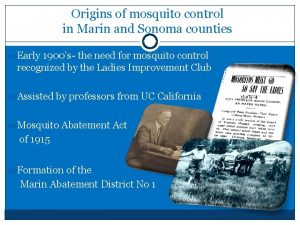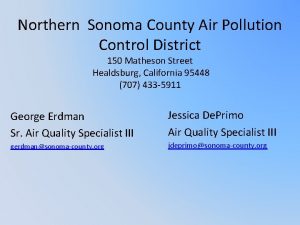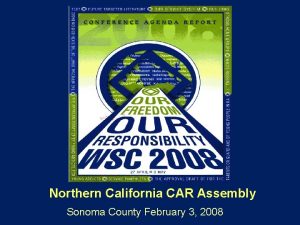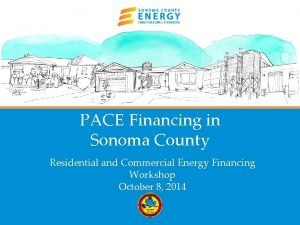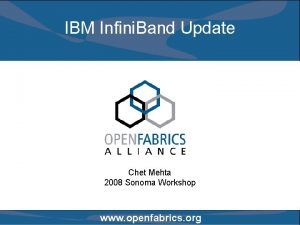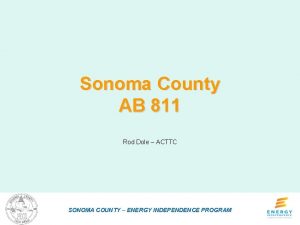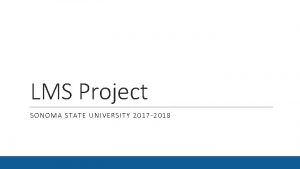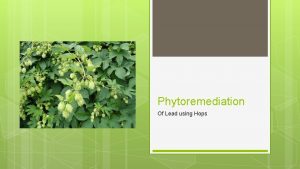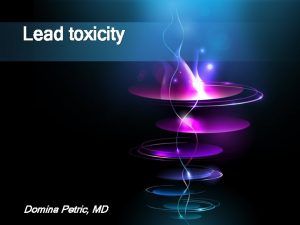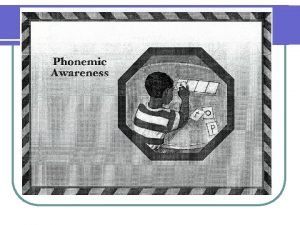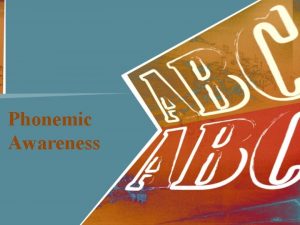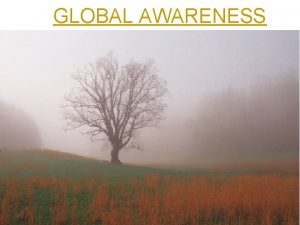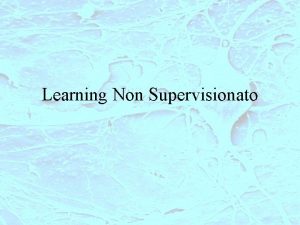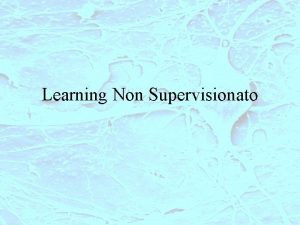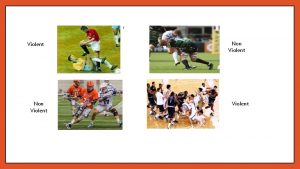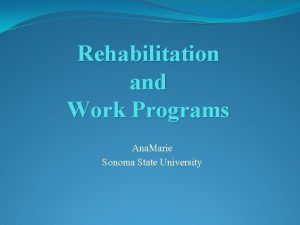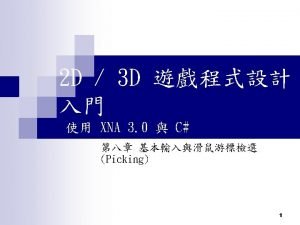Lead Awareness for Non Leadworkers Sonoma State University




























- Slides: 28

Lead Awareness for Non Lead-workers Sonoma State University Department of Environmental Health & Safety

INTRODUCTION

What is Lead? l Heavy metal at room l l l temperature Bluish-gray Low melting point Pliable Corrosion resistant Can form lead compounds 3

In what products was lead commonly used? l Gasoline (phase-out began l l l 1980) Smelting Lead batteries (25 -78% of all lead used in U. S. ) Paints and coatings Solder Auto manufacturing Printing 4

History l Late 1950’s – Paint manufacturers started to voluntarily reduce lead content in most paint for residential use. l 1978 – Consumer Product Safety Commission (CPSC) limits paint for residential use to 600 ppm (essentially, lead-free paint). l However, lead paint for non-residential use is still sold. 5

So where is lead paint found? l Homes built before 1950 – Everywhere – inside and outside (all coatings) l Homes built between 1950 -1960 – Probably outside, may be inside – Trims, doors, windows, kitchens, bathrooms, etc. l Homes built between 1960 -1978 – May be outside, less likely inside ***Before 1978 we assume lead!!! 6

What is “lead paint” l EPA/HUD/DHS Definition 1. 0 mg/cm 2 5000 ppm 0. 5% l California Definition 1. 0 mg/cm 2 or 0. 5% lead by weight l OSHA and Cal OSHA Definition Any detectable amount 7

Where could I find lead on campus? 8

Buildings on Campus & Year Built Building Date Built Art Complex 1967 Physical Education 1969 Darwin Hall 1967 Rachel Carson Hall 1975 Nichols 1975 Schulz 2000 Boiler (Central) Plant 1967 Ives Hall 1967 Stevenson Hall 1967 Person Theatre 1989 Last Renovated 2004 9

Buildings on Campus & Year Built Building Date Built Renovated Salazar Hall 1969 2000 International Hall 1976 2014 Commons 1968 Housing Cabernet 1972 Zinfandel 1972 Verdot 1972 Sauvignon 1999 Beauojolais 2003 Tuscany 2012 10

HEALTH HAZARDS

Ways in which lead enters the body l Inhalation - Breathing lead fumes or dust. This is the most common route of entry in the workplace. l Ingestion - Swallowing lead dust via food, cigarettes etc. 12

Health Effects l Lead which is inhaled or ingested gets into the bloodstream. l Can be circulated throughout your body. 13

Health Effects l Some is excreted while some remains in organs and body tissues. l If exposure continues, the amount stored in your body will increase if you are absorbing more lead than your body is excreting. 14

Chronic Health Effects During prolonged chronic exposure, many body systems can be affected by lead, including: l Brain l Kidneys l Muscles l Bones l Blood forming organs l Reproductive systems 15

Chronic Health Effects (Resulting from High Lead Exposure and Absorption Into Body) l Severe damage to blood forming, nervous, urinary and reproductive systems l Loss of appetite, metallic taste in the mouth, anxiety, constipation, nausea, pallor, excessive tiredness, weakness, insomnia, headache, nervous irritability, muscle and joint pain or soreness, fine tremors, numbness, dizziness, hyperactivity and colic (with severe abdominal pain) l Person is easily irritated and may become aggressive 16

Chronic Health Effects l Reproductive systems of both men and women may be affected – Decreased sex drive, impotence and sterility in men – Miscarriage and stillbirth in women whose husbands were exposed to lead or where they were exposed 17

Chronic Health Effects l Children born of parents who were exposed to excessive lead are more likely to have birth defects, mental retardation, behavioral disorders or die during the first year of childhood 18

Other Chronic Health Effects Hypertension l Lead exposure has been consistently associated with increases in blood pressure in studies conducted in both workers and the general population. l Blood lead levels of less than 20 μg/d. L sometimes are associated with increases in blood pressure. 19

Other Chronic Health Effects Decreased kidney function l Low to moderate levels of lead exposure also have been associated with adverse changes in kidney function. l This association may be even worse in people who have other risk factors for kidney disease, such as hypertension or diabetes. 20

Acute Health Effects l Acute health effects only appear when worker is exposed to extremely high amounts of lead l Acute encephalopathy (disorder or disease of the brain) may develop quickly followed by seizures, coma and death from cardio-respiratory arrest l Again, highly unusual, but not impossible 21

CONFIRM PRESENCE/ NON-PRESENCE OF LEAD CONTAINING MATERIALS

Lead Identification l Department personnel should contact the Department of Environmental Health & Safety (EH&S) prior to the disturbance of painted surfaces unless it is known with certainty, either through documentation or testing, that the surface does not contain lead. 23

What to Know as a Bldg Occupant l If building becomes damaged (floor, walls, ceiling, or components appear damaged) – Damage includes, holes in surfaces, peeling paint, broken floor tiles, contact surfaces degrading l If you want to modify anything on the building including hang a picture, connect or disconnect anything to or from structure, place a work order – Telephone 4 -2308 – Email seawolf. servicecenter@sonoma. edu 24

Conclusions l Buildings are maintained to minimize potential for lead containing or other potentially hazardous materials to become airborne l Processes described earlier help ensure necessary activities can be safely conducted by occupants or trained staff as previously defined. 25

Lead Poisoning Prevention (For the Non-Lead Worker) l Minimizing exposure to lead is the key to minimizing health effects 26

Could I find lead outside of campus? l If your home was built before 1978, it may contain lead based paint. l Hobbies: stained glass, home remodeling or painting, recreational target shooting, melting lead for fishing weights, lead glaze in ceramics. l Non-occupational exposures: backyard scrap metal recycling, leaded crystal tableware, pewter, cookware, folk remedies, pica, mine tailings, beauty products (eye make up, certain hair dyes). 27

Questions? 28
 Cvs privacy awareness and hipaa training answers
Cvs privacy awareness and hipaa training answers Sonoma county vector control
Sonoma county vector control Northern sonoma county air pollution control district
Northern sonoma county air pollution control district Sonoma county na
Sonoma county na Sonoma county energy independence program
Sonoma county energy independence program Sonoma interconnect
Sonoma interconnect Intermediate scrutiny
Intermediate scrutiny Frequency dependence of dielectric constant
Frequency dependence of dielectric constant Debout jeunesse lève toi
Debout jeunesse lève toi Disease state awareness
Disease state awareness Nonobvious relationship awareness
Nonobvious relationship awareness Fspos vägledning för kontinuitetshantering
Fspos vägledning för kontinuitetshantering Typiska novell drag
Typiska novell drag Nationell inriktning för artificiell intelligens
Nationell inriktning för artificiell intelligens Vad står k.r.å.k.a.n för
Vad står k.r.å.k.a.n för Varför kallas perioden 1918-1939 för mellankrigstiden
Varför kallas perioden 1918-1939 för mellankrigstiden En lathund för arbete med kontinuitetshantering
En lathund för arbete med kontinuitetshantering Underlag för särskild löneskatt på pensionskostnader
Underlag för särskild löneskatt på pensionskostnader Tidbok för yrkesförare
Tidbok för yrkesförare Sura för anatom
Sura för anatom Densitet vatten
Densitet vatten Datorkunskap för nybörjare
Datorkunskap för nybörjare Boverket ka
Boverket ka Mall debattartikel
Mall debattartikel Autokratiskt ledarskap
Autokratiskt ledarskap Nyckelkompetenser för livslångt lärande
Nyckelkompetenser för livslångt lärande Påbyggnader för flakfordon
Påbyggnader för flakfordon Tryck formel
Tryck formel Offentlig förvaltning
Offentlig förvaltning

